Alfred Silvester – the Fakir of Oolu and his Family of Magic
Chapter Thirteen – The Touring Years 1920 - 1929
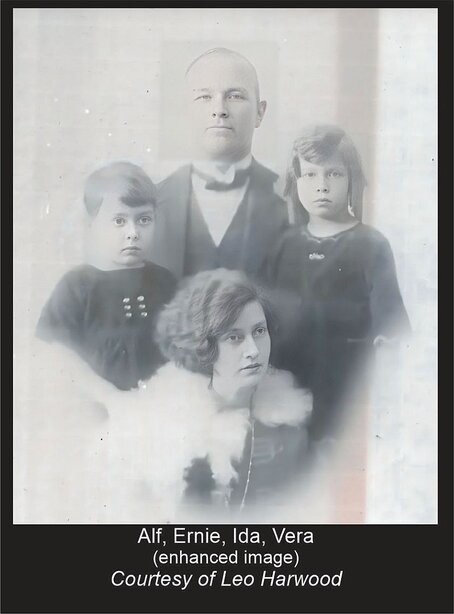 “After the hard work was done we would start rehearsing for the evening show. And we would practice, and practice, and practice until we had everything perfect. We would repeat our lines over and over, or run through our trick over and over again, until we almost knew them in our sleep. This was the professionalism that Alf instilled in us. There was only one standard; the very best that we could do.” - Ida Harwood, step-daughter of Alf Silvester
“After the hard work was done we would start rehearsing for the evening show. And we would practice, and practice, and practice until we had everything perfect. We would repeat our lines over and over, or run through our trick over and over again, until we almost knew them in our sleep. This was the professionalism that Alf instilled in us. There was only one standard; the very best that we could do.” - Ida Harwood, step-daughter of Alf SilvesterThe structure of this chapter will be considerably different from what has gone before, and some preliminary explanations are in order. We have followed the Silvester family tree along the line of magician performers and, as the family lineage expands, have confined our record to those who were theatrical performers themselves, or had a significant involvement in the history of the magicians. The selective family tree provided in Chapter One will be left incomplete after the year 2010 as family members are still living, and the tree has widened to proportions which are outside the theatrical scope of our story.
Alf Silvester’s itinerary, from about 1921, will not be traced in minute detail, since his final touring years took him on a vast adventure across countless tiny towns whose details add little to the tale. As well, this period of his life is already documented from an entirely different angle – the viewpoint of his step-daughter and touring troupe member, Ida Harwood.
IDA – THE LADY ON THE SILVER WIRE
The life of Ida Williams/Harwood will be detailed later in this chapter. She was the step-daughter of Alf Silvester but also, for reasons which will be explained, a direct descendant (fourth generation) of the Silvester bloodline.
Having grown up from her early years as a performer with the Silvester troupe, Ida spent her entire life as a variety performer, and in the 1980s she partnered with the State Library of Western Australia (1) to create both audio interviews and an extensive written memoir about her life, in the process relating detailed and candid memories of Alf Silvester. “Ida – The Lady on the Silver Wire”, though not widely reprinted, is a truly remarkable oral history and an invaluable record of the Australian touring show as it existed through the Depression years. At some 90+ pages, Ida’s entire memoir is not reproduced here, but we will selectively quote throughout this chapter, and use her document to flesh out the details of Alf Silvester’s character and final years.
MUSEUM OF PERFORMING ARTS AND FAMILY RESOURCES
Ida Harwood and family members have also contributed a large array of documents and photographs from the post-1900 period, to the Museum of Performing Arts curated at Perth’s “His Majesty’s Theatre” which in 2010 presented a display titled “On the Road with Baby Ida.”
A select number of images are reproduced here, but many more of interest may be found at:
Numerous originals and older historical Silvester/Harwood images have also been made available for use with the kind support of Ida’s immediate family, Leo Harwood and Lyn Myers.
Before we can continue where Chapter Twelve left off in 1921, we need to backtrack quite a number of years in order to identify and explain the history of Alfred’s newest mind-reading partner, “Zodiac.”
VERA WHALEY SILVESTER
Chapter 8 relates the history of Charles Silvester, son of the original Fakir, and Charles’ wife, Elinor [Eleanor] Georgina Whaley (2). They had travelled with their young children in a fraught tour of New Zealand in 1895, during which a young Alfred William Silvester had joined them, coming back to Western Australia with the family until Charles unexpectedly died in June 1896.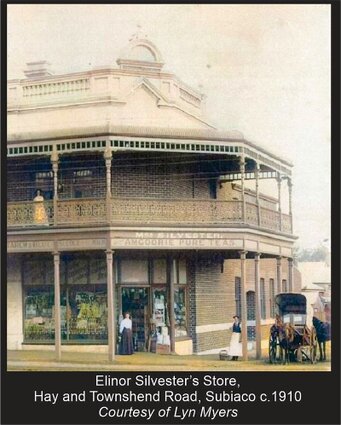

Of Eleanor and Charles’ seven children, only four lived past the age of twelve, and tragically their youngest, Horace Claude, died at the age of five months in the same year that Charles passed away. A few years later, in 1902, Eleanor had the further grief of losing her daughter, Hillgrove Ida, at under twelve years old, following a ‘long and painful illness.’
The youngest of the surviving children (Charles Ernest, Elinor May and Catherine Alice) was Vera Whaley Silvester (1892 – 1970) taking her middle name from her mother’s maiden name. She had appeared on stage with the whole family in New Zealand, billed as “Baby Vera” which indeed she was.
As Eleanor Silvester created a living for herself, one of her notable community involvements was to hold an annual Ball at Subiaco, which she did for many years from 1899. At the 1902 ball, little Miss Vera Silvester was noted as having danced a sailor hornpipe which was “well received.” In the ensuing years, Vera and her siblings were seen at the ball in fancy dress costumes, and by 1904 Vera was becoming a featured singer and pianist at these and other local affairs (in March 1915 the West Australian wrote that “Miss Vera Silvester, in her song, ‘A Serenade to the Moon’, proved herself the possessor of a pleasing voice and a dainty manner, and she thoroughly earned an unmistakable recall.”)
“All my mother’s family were musical in one way or another; her sisters Kate [Catherine] and May [Elinor May] all sang and played the piano equally well, while Uncle Ernie sang and played the trumpet. Auntie May had a very good soprano voice and sang with the J.C. Williamson organisation for many years before she met and married Jim Goodlet … while mother was single she commenced playing the piano at the Regal Theatre during the silent movies.” – Ida Harwood
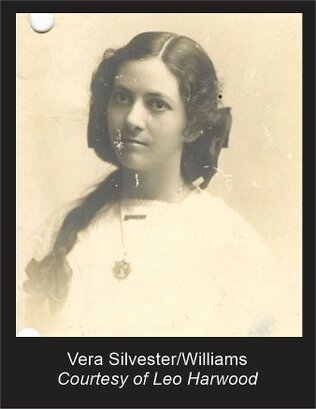
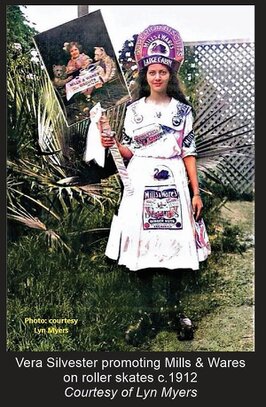
Another of Eleanor’s activities was to run dancing classes at the Subiaco building and by 1912 daughter Vera was also giving twice-weekly juvenile dance classes.
On November 26, 1915, the engagement was announced of Vera Silvester (aged 23) and Mr. Edwin Joyce Williams, an employee of the automatic telephone exchange in Perth. The pair married on March 11, the press reporting on the dresses of mother, bride and bridesmaids.
Vera and Ted settled at 175 Barker Road, not far from Eleanor’s shop, and Vera bore two children:- Ida Elinor slightly premature on November 26 1916, and Ernest Edwin on August 1 1918.
TRAGEDY STRIKES
At the start of 1919 Australia, having battled through the Great War, was faced with another scourge, this time the pandemic of Spanish Influenza. Quarantine procedures had been put in place in late 1918, but some forty percent of the population were affected by the ‘flu, and an estimated 15,000 people succumbed by the end of the pandemic a year later.
Ted Williams was amongst the many who died. He was at the Blackboy Hill isolation camp hospital (4) and passed away on August 13, leaving Vera as a widow with two tiny children. To make matters more difficult, Vera’s mother Eleanor died on February 2, 1920 (5).
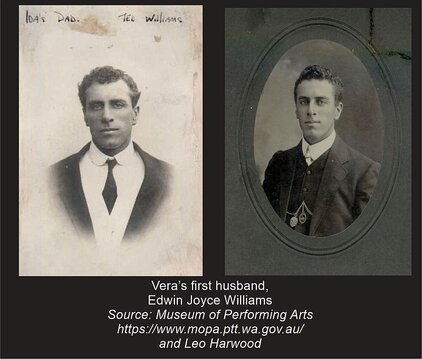 “Mother must have been devastated by this sudden tragedy. With two small children to rear in a hard world and with very little money, her future must have seemed bleak indeed. The family helped as best they could and I know that Aunty Kate, who by now was Mrs. Burton and lived close by, was a great help to her. Father [Edwin] had been a member of the Freemasons, and they were very helpful in helping Mum borrow enough money to buy their home, and so secure a roof over our heads. She had to repay this loan, of course, and this must have been a struggle for her.” – Ida Harwood
“Mother must have been devastated by this sudden tragedy. With two small children to rear in a hard world and with very little money, her future must have seemed bleak indeed. The family helped as best they could and I know that Aunty Kate, who by now was Mrs. Burton and lived close by, was a great help to her. Father [Edwin] had been a member of the Freemasons, and they were very helpful in helping Mum borrow enough money to buy their home, and so secure a roof over our heads. She had to repay this loan, of course, and this must have been a struggle for her.” – Ida HarwoodFAMILY TREE COMPLEXITIES
Before we continue from 1920, a few final topics will inform the coming story.
Firstly, a brief reminder of the Silvester family bloodline. Allowing for the many non-performing descendants, the bloodline of the theatrical members of the family was via Vera Silvester/Williams – starting from the original Alfred Silvester, to his son Charles, then to Charles and Eleanor’s daughter, Vera. That bloodline continued through Vera and Ted’s daughter, Ida, and then to Ida and Douglas Harwood’s children who form the present-day generation of performers, of which Lynette Myers is still an active part.
The extent to which Alf Silvester kept in touch with his family members is unknown, but there are some clues that he must have maintained some connections. The magical routines he performed were largely the stock-in-trade of his forebears - The Entranced Lady, Masks and Faces, Second Sight, Vanishing Glass of Water etc all suggest that he received training in these feats, either from Charles Silvester in the brief period of their association, or in some way via Alf’s father (Alfred2) who lived in Melbourne and Adelaide up until 1907. Alf performed with his sister, Daisy Silvester/Kenny, for a short time in 1920, and it seems quite likely that he would have been well aware that Vera Williams’ husband had died. He apparently wrote to his New Zealand wife, Evangeline, but sent them no support money.
Finally, Alf Silvester and Vera Williams would, in time, marry. The fact is that there was a near twenty-year age difference between the pair, and they were also first cousins – not something against the law, but which slightly increased the genetic risks of having children. This may have raised some eyebrows in the community, and throws a considerable twist into the complex Silvester family tree.
Ida Harwood’s memoir suggests that Alf and Vera married somewhere around 1920, very early in her life. She may have been relying on family memory, because official records show that the pair did not actually marry until April 30 in 1929 in Queensland (6), some nine years after they first joined forces in showbusiness.
Several reasons would factor in to this marriage date. Firstly, the obvious time taken to form a relationship which probably did not exist in 1920. Secondly, Alfred was still a married man in New Zealand, and it was not until September 1927 that his wife, Evangeline, filed for a decree nisi, at which time she stated that her husband’s whereabouts were unknown. Lastly, Alf and Vera had produced two children of their own; Eric Ronald Silvester (b.1930) and Shirley Silvester (born at Inverell in March 1935). Propriety would have encouraged that the parents be married.
ALF AND VERA JOIN FORCES
At last, having laid the groundwork for the story to follow, we can return to 1920 where, in July, Alf Silvester and his then-partner, Astras, arrived in Perth for a successful season at the Shaftesbury Theatre. During the eight or so weeks they were there, Alf must have had discussions with Vera Williams about her future. It is unknown whether Alf might have motivated the change of partners, or if Lola Maiden/Astras was already talking about branching out on her own. For Vera the decision to join forces with Alf Silvester was a big move – she had not been out of Perth since her parents had brought her there, and despite having had some experience in performing as a tiny tot, she was by no means an experienced theatrical. The further consideration, of course, was her two young children; Ida not yet four, and Ernie a veritable baby of two.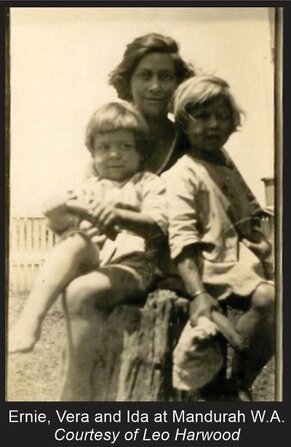

What would have been Alfred’s motivation at this time? It is most unlikely that any romance existed between the couple, and based on his relationship with his own children, Alfred was not looking to find himself a family. For the next several years he may have been the childrens’ guardian, but was not their step-father. Alfred was seventeen years older than Vera, some 5’9” tall but very stockily built, while Vera was (according to her daughter), “a tiny lady, almost delicate, remaining this way all her life and never weighing more than a little over seven stone.”
There was certainly the aspect that Vera was struggling financially after the loss of her husband, and Alf would have wanted to help her. As well, if ‘Astras’ had already made up her mind to leave the partnership, Alf would have been in need of a new mind-reading lady, and here was an ideal opportunity. The appearance is that of a purely pragmatic arrangement on all sides.
ZODIAC TAKES OVER - 1920
From Western Australia it seems that the whole group travelled by ship back across to New South Wales where, up to November 17, Astras and Silvester continued to perform together at Fuller’s Theatre in Sydney. It was on November 27 that ‘Zodiac’ made a first appearance, and since they were out west at Lithgow, this may have been an out-of-town trial of the new partnership.
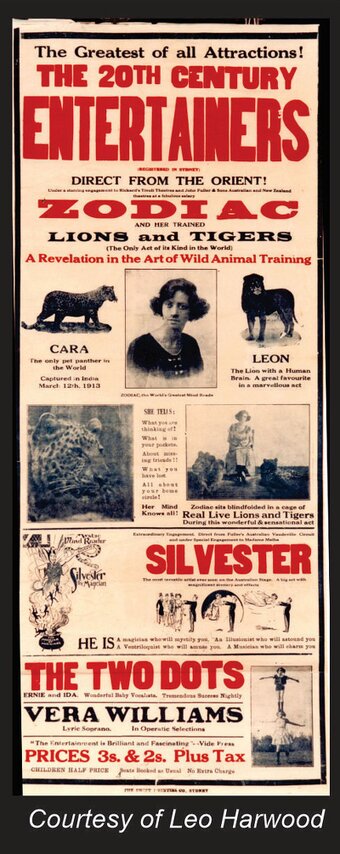
Astras had now effectively left the show, and Vera continued to present the mind-reading act in much the same setting, with Cara the leopard, and sometimes Leo or Daisy the lions, at her side on the stage. Without the logistical support provided by the giant Fuller Circuit, Gordon Maiden now continued to act as advance agent, and the company now became known as the 20th Century Entertainers. For the most part, the troupe was small, with Alf and Vera presenting the bulk of the show, although there some other support acts including the Carroll Sisters who were friends of Alf’s billed as singers, dancers and patter artists.
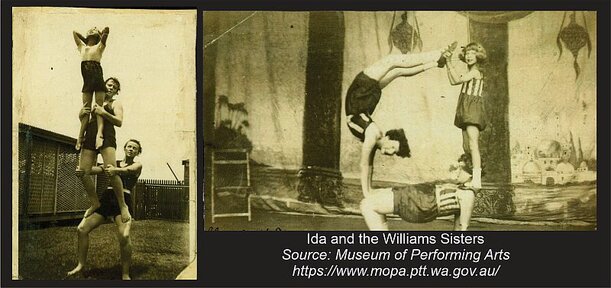
Also billed during the early 1920s were “Williams and Williams”, musicians, bellringers and vocalists. It is not clear who these were, though one was certainly Vera Williams. In later years more Williams Sisters travelled with the company, “Bootsie” (Lucy) and Mavis, with Ida helping to forming the acrobatic trio. These sisters had no family relationship to Vera.
TRAVELS TO 1922
Without attempting to follow every move of the Entertainers, they spent the first couple of years on the east coast of Australia, mostly aiming for the larger coastal towns but moving over long distances in New South Wales and Queensland – the travel between Sydney and Cairns (Queensland) was 1700 kilometres, almost enough to drive the length of the United Kingdom twice over, but not even approaching the mileage they would later cover. By September they had moved down to Victoria where, in October, Alf was noted at Geelong giving a daily bath to Leo the lion outside His Majesty’s theatre, and in Melbourne lodging Leo in a small yard in Spencer Street (“He won’t touch you – he’s as quiet as a child”) along with the leopard and a wild fox.
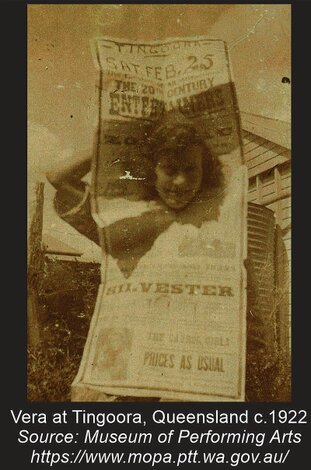
In April of 1922, ‘Everyone’s’ magazine reported that Silvester had joined the slew of magicians presenting the new illusion “Sawing A Woman in Two.” He called his version “A Woman Cut in Two”, and claimed it was no imitation of the Sawing, saying that Dr. Silvester the Fakir of Oolu introduced it to Australia over fifty years ago. Whatever ‘dismemberments’ the Fakir might have once used, they were not anything that resembled the theme of Selbit’s sawing illusion.
Gradually, the show was changing into a touring Variety troupe. Alf had the versatility to present magic, juggling, ventriloquism, shadowgraphy and any number of entertaining routines, while Vera was the mind-reader, Entranced Lady, and a featured singer of ballads, not to mention playing handbells and other quaint instruments such as the xylophone, water glasses, handbells and even an inflated bicycle tube. By 1922 she was billed twice in newspaper advertisements, once as Zodiac ‘The Wonder Woman’, and then as Vera Williams in her musical turns. Vera was also said to be “late of the Marmion Bellringers”, but if that group ever existed it cannot be located. With the animals as a sure-fire publicity gimmick, they had a repertoire large enough to cover any full evening show. Magic was still Alf’s primary act, but he was not now solely a magician in the way that his father, uncle or grandfather were.
Alf had learned the necessity of becoming a generalist entertainer, and the times were changing. The advent of both Radio and Motion pictures was, more and more, making inroads into live entertainment, and variety performers were frequently seen as just one half of a show, followed by a movie presentation. In later years, this would reverse, and the movie was the main attraction with novelty acts presented as supporting features, until the age of Variety came to a creaking halt. What remained were the family and travelling shows which were prepared to move all over the country bringing entertainment wherever there was a prospect of an audience.
Some magicians made a good, though hard-earned, living; Charles Sloggett, Will Alma, George Waldo Heller and Maudeena, and Les Levante’s family all worked the smaller towns for many years. There was less advertising needed outside the population centres, better rents for local halls, and a good prospect of attracting an audience from the district around the town. For the Silvesters, the years up until 1930 seem to have been prosperous in terms of audience numbers if not wealth, provided they put in the effort of travelling. When they were engaged by George Marlow’s Grand Opera House in Sydney, the fortnight’s contract was at thirty pounds a week.
In many ways the next two decades are far more interesting than the period in which Alf had lived a comfortable suburban existence with assured bookings. The sheer grit, resilience and determination shown by travelling show-people informs us of the true social conditions across Australia and provides an understanding that cannot come from newspaper reviews and advertising alone.
IDA AND ERNIE – THE TWO DOTS
Vera’s two children, Ida (b. late 1916) and Ernie (b. 1918) were too young to be appearing on the stage, at least on a regular basis. Most often they would be left in care at a hotel or boarding house while their parents went out to the next theatre job. Ida’s own memories only surface from the time she was five; yet at Cootamundra in August 1922, the paper mentioned that “Little Ida, a four year old with a pretty voice added to the harmony” and by 1923 Ernie had been included on the bill, where they were either promoted as ‘The Two Dots’ or as ‘Baby Ida and Baby Ernie’ performing songs for the audience.
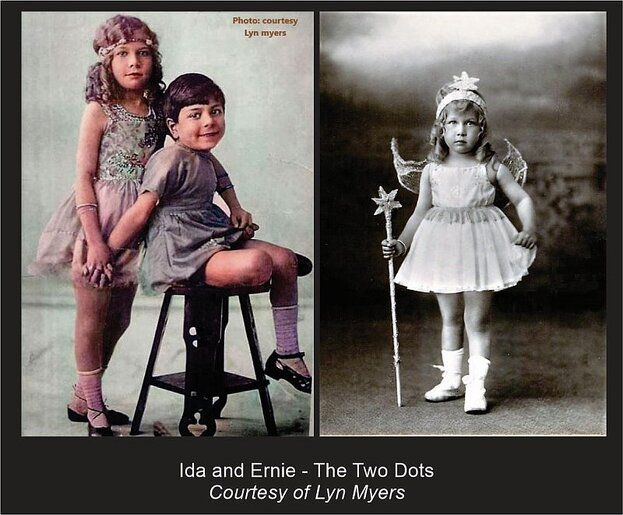

“After Ernie and I had grown into adulthood and started looking back on the years we had worked in the family show, we came to realise just how talented Alf Silvester was. Really, he could well have been the most talented all-round entertainer Australia has seen. Where most entertainers concentrate their efforts into a specialised line of work, Alf was a most remarkably versatile performer. He could juggle well for instance. One of his routines was to spin a steel hoop around his body and neck, similar to a child with a hula-hoop. To make the act more difficult he would place a glass of water on a flattened section of the hoop and carry out the routine without spilling a drop … Although Ernie and I were still too young to join Alf and Mum in the show, he had started teaching us little routines and songs to enable us to take our places in a true family show. Just after I turned six years of age, with Ernie not yet five, we made our debuts with these songs and patter routines. Even at so young an age Ernie had a sweet little voice and could follow any key changes quite easily. We started singing little ditties together, like this one about members of the audience:
"There sits a man with his girlie by his side, And I bet you soon she will be his bride -
Very soon she will be his missus.... " ( and Ernie would pipe in with)
"Then she will keep him home at night, To help her do the dishes! "( then we would both sing)Very soon she will be his missus.... " ( and Ernie would pipe in with)
"Tum tiddley um tum, tum tum.”
They were only simple children’s songs but they were extremely well received by the audiences of the day.” - Ida
As they grew, Ernie would become the singer and comic performer (later billed as “The Pocket Comedian”). He was a bird collector, and caught the harmless pythons that were used in the show. Ida was the more athletic of the pair, and her repertoire quickly expanded, under Alf’s tutelage, to include contortion, acrobatics with the Williams Sisters, a brief foray into bare-back horse riding, clog dancing, and walking on the slack-wire (a different skill to the tightwire) which became her featured talent well into middle-age. She would assist Alf by pulling strings offstage during his magic act, and often carried snakes wrapped around her shoulders while navigating the wire. Ida was no less talented in the musical arena, taking on singing and playing a multitude of standard and obscure musical instruments. In the 1930s, with Vera, the family billed themselves as the ‘Sils Family Bellringers’.
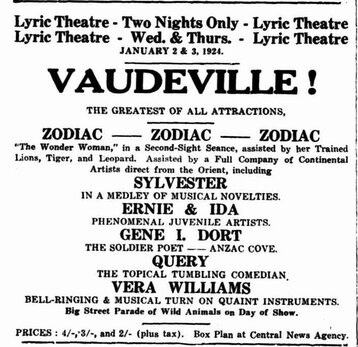
The children, as was the case with any show family, were not coddled, nor did they really have a choice about being in the show. They would often sleep in an ad-hoc bed at side stage, and would be awoken in time to perform their routines:
At this time of night we were usually still half asleep and very crotchety and grumpy and we would start jostling and hitting each other, each trying to get the last hit in before we were in full view of the crowd. As we stood there waiting for our cue, pushing and jostling, the audience thought it was just another comedy routine and usually started laughing at us. Mum often wondered if they were laughing at the show or simply at the two grumpy children standing there. Really, we were merely two cold and tired children who wanted to get back to their warm bed, even if it was on the floor behind the piano. I still have vivid memories of being dressed in skimpy costumes, standing in the freezing wings of the stage, waiting to make an entrance. Over the years I came to understand just what a hard life it was for young children.
Alf was a very hard task-master and we all had to work extremely hard to satisfy him. He was a well-known and respected act in his own right, a very professional performer, and everything we did had to be up to his very high standards. We spent many, many hours learning our lines and our tunes, or perfecting our parts in any magic acts we might be helping with. Not only us kids either, Mum had to work just as hard, particularly when perfecting the Mind Reading acts she and Alf performed. All this practising and rehearsing filled in our childhood days, which was just as well for us. Unless we were staying with people who had children of their own, either landlords or friends of our parents, Ernie and I didn't have the company of other children. We had no playmates of our own as other kids, who lived more normal lives, had. We were pretty much "loners", I suppose. - Ida
Ida recalls that Alf was, besides being a perfectionist, not a regular drinker, which probably set him apart from many of the other touring companies. She mentions a couple of occasions on which he meted out corporal punishment to his children, which would not have been unusual at the time; but for the most part he was, along with Vera, a good role model for the children, sending them to school even for a single day or two at whatever town they were in, off to the Salvation Army church services, and learning to behave in a respectful manner in public.
Alf, however, was probably the tough and stoic example of manhood which did not reveal the difficulties he might be enduring – the notion of men’s ‘mental health’ did not remotely exist at the time. One of Ida’s memories, during the Depression years, was waking to see Alf standing in the bedroom, holding a gun. Nothing happened, and nothing was said, but clearly he was a man under pressure to find the next show, or the next tank of petrol, or the next meal.
SUMMARY OF YEARS 1923-1936
The show’s format did not vary radically in the years 1923-1936, and rather than attempt to follow the troupe’s every move, an indicative listing of their schedule is given at the end of this chapter. It would, in any case, be impossible to discover every venue they played, since many of the towns were barely even that – even today some of the places are little more than a few square blocks of township, with most audience coming in from far and wide out of the farming, mining, and livestock stations in the region.
Ida mentions that when they were based at Inverell (c.1935) they went out to perform at Tingha, Yetman and Emmaville, within 100Km from Inverell, returning to the boarding house each night. These, and countless other shows, are probably untraceable today. Advertising by newspaper was not always a viable way of promoting the show, and a good advance agent would have gone ahead to put up flyers; or Ida and Ernie would be sent out:
If there was time Ernie and I might set off delivering small hand bills from door to door, advertising the show. There was none of this letter-box stuffing that goes on today, Alf insisted that we went right up to the house doors and knocked the people up. We were to meet them face to face, and handing them the bills were to tell them how good the show was, and invite them to come along and see for themselves. Alf would have had a piece of us if he found out that we just poked the bills in letter-boxes. With the amount of "junk mail" that comes our way now house-holders would be at the door all day, so it is probably better that this custom has died out. - Ida
In 1923, then, the Silvesters took most of the year to gradually move through country Victoria, through South Australia and eventually back to Western Australia and Perth, which was home base for them and other family members.
Across the years Alf Silvester would adopt any number of new company names, and another pseudonym for himself, “Chas. Allan”. The show can be found under a long list of titles, of which this is probably an incomplete listing:
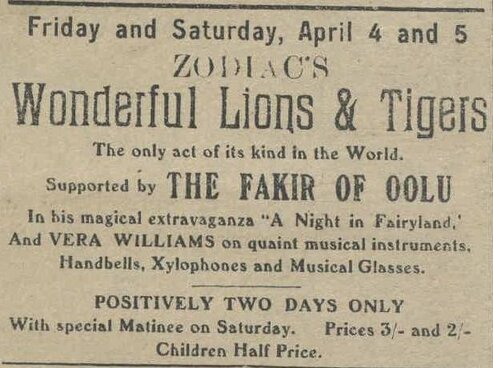
Lex McLean Silvester Novelty Co. in New Zealand
Silvester Family of Entertainers
The Tivoli Touring Theatre Company c.1917 when Alf was "Silbini"
Silvester and Astras in 1920s
The 20th Century Entertainers to 1925 +
The Sills Family or Sils Family 1926 and as late as 1938
The World's Entertainers May 1926
Silvester's Vaudeville Co. late 1926
Sills New Novelty Company 1926
Chas. Allan's Surprise Party 1927
Zodiac's Oriental Entertainment (or Entertainers)
Kit-Kat Comedy Company
Allan's Bell Ringers and entertainers c.1929-30
Act promoted as "Twenty Minutes in Wonderland" or more often "A Night in Wonderland / Fairyland”
Vaudeville and Specialty Show - W.A in 1937
The Hollywood Entertainers c.1938 with Alf named as producer
Silvester the Great 1938
Alf also used the name “Fakir of Oolu” in his advertising, on occasion.
If we had advertised the same touring company, using the same name each time we visited a town, probably nobody would have been interested in turning out to see us, and we could well go hungry. There was more than one occasion as it was when Alf had to decide whether to buy food, or petrol enough to get us to the next town. If we had suffered a bad turn-out at one town, the next one on the route just had to be better. In circumstances like that Alf almost invariably bought the petrol. Times weren't always good to us, and working in a travelling variety show could be a very thankless way of making a living. - Ida
WESTERN AUSTRALIA 1924 - 1926 - TRAVEL AND ANIMALS
Back at Perth, Alf would remain in Western Australia for the next three years. It was certainly not a matter of staying close to home – even a ‘local’ trip to Bunbury involved a trip of 170 kilometres, or 412 Km to Geraldton, 530 Km to Meekatharra. The state, making up a rough third of Australia’s land mass, is large enough to contain Germany, Sweden, Portugal, Korea, Switzerland, Spain and Poland with room to spare, with a population today of less than three million. Travelling inland to places such as Kalgoorlie or Mount Magnet was a logistical challenge through scrubby landscape, outback roads which were little more than bush tracks, and the risk of breaking down or getting bogged in sand during summer, or mud in winter, while the show equipment and performers suffered through dust, heat and insects.
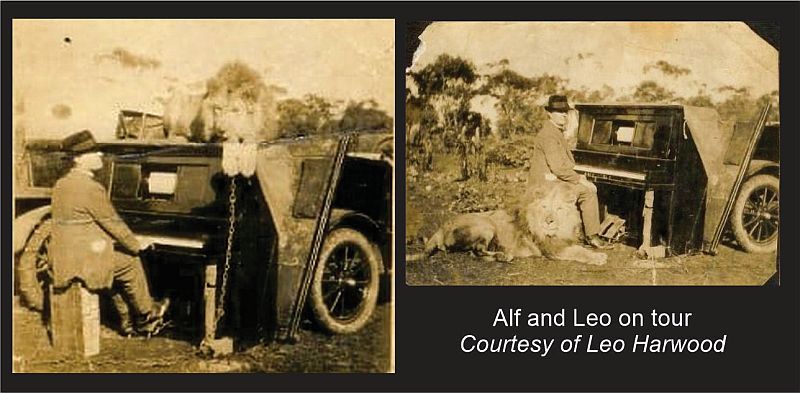
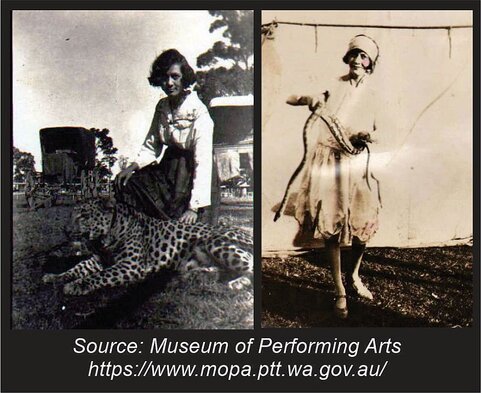
It was not just the human performers who had to travel under these conditions. The various animals of the show also had to be transported, fed, exercised and housed. These included Leo the lion and Daisy the lioness, Cara the leopard, a pet bulldog, the many snakes (harmless pythons), birds for Alf’s vanishing birdcage trick, and two dog-faced baboons named Charlie Chaplin and Jennie which performed comic acts on stage by playing musical instruments or pulling each other around the stage in a wheelbarrow.
All our animals were well looked after, they were always well fed and received as much exercise as Alf could give them. Despite being "wild" animals they were really just like big dogs as far as we were concerned, with the understanding that they were potentially dangerous big dogs, never to be taken for granted. We children were well taught to treat them with a great deal of caution and respect… If one of the lions licked us on the arms, or worse, on the face, it was like being rubbed down with a wood rasp, his tongue almost taking the skin off. And as I have mentioned, a friendly cuff was like being punched in the head … Alf looked after the menagerie as well as he could, exercising them regularly. Quite obviously he couldn't let them run free around the local parks, although they probably would have caused no harm, so he would walk them, on strong chains, just like dogs. If he was unable to do this outside he would walk them inside the hall, and let one of them roam freely there overnight, after the show. They would take turns to have the run of the place at night.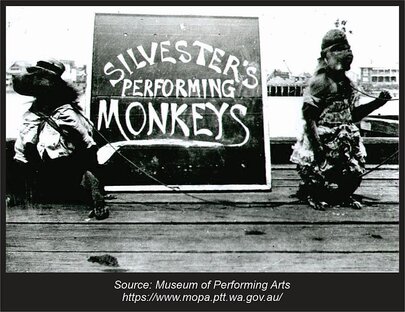

As I have said monkeys can be sneaky and we had to watch them carefully. They could be sitting quietly, behaving themselves and in a flash swing out to the extent of their chain and grab hold of you, pinch you, generally with their back feet. It is the back end of a chained monkey that you have to watch, not the front. - Ida
The animals, despite the work involved in keeping them, were publicity gold. Alf would drive through a town (even once through Adelaide) with the lions displayed on the back of his truck, guaranteeing a crowd and any amount of free publicity. Daisy the lioness was also featured in a challenge ‘tug of war’ between herself and a local citizen. Chained for safety, Daisy would sometimes win a match, and occasionally lose; what the punters didn’t know was that Alf could give subtle signals to Daisy to either ease up on the rope, or to pull hard and win the match. The first match might be lost, at a cost of £5 to Alf, which he subsequently recouped (and more) in wins.
 Vera, who was most often billed as Zodiac, or Princess Vera (or De Vera) made the most out of the large cats, who idled away their time on stage during her mind-reading routine with Alf.
Vera, who was most often billed as Zodiac, or Princess Vera (or De Vera) made the most out of the large cats, who idled away their time on stage during her mind-reading routine with Alf. While they were performing this act Alf would walk among the audience, continually talking both to them and to Vera. He would stop from time to time to take an object from one of the crowd, or perhaps invite another to choose a numbered card from a selection he offered them. Once this had been done Madam Zodiac would, by the concentration of her great mystic powers, read Alf's mind and announce whatever the object or number was. This was a powerful act and held audiences spellbound every time. So great were her powers that she always gave him the correct answer .
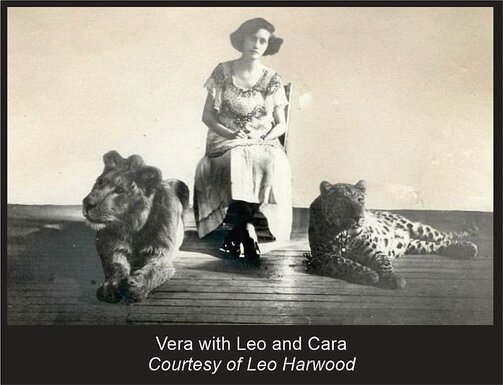
The amount of practice and concentration that went into the perfection of this act was very tiring for them both. Without knowing how the routine worked you can imagine just how much preparation a performance such as that would entail. It had to be right every time, not sometimes or most times, but every time. It deserved all the applause it received. - Ida
(As a partial indication of the kind of work that may have been involved, see some of the techniques explained by Alfred2, in the Appendix – “A Mental Phenomenon.” These were not necessarily identical to the methods used by Alf and Vera.)
On the rare occasions we were at home the animals were kept in our backyard at Barker Road. They were quite comfortable there and it suited us fine to have them close by. Unfortunately our neighbours didn't agree with us, and eventually their complaints became so loud and clear that Alf was forced to board out the lions at the Perth Zoo. It was only the lions that went there, and for reasons that I never knew, Cara stayed at home with the rest of us. Perhaps he was quieter than the lions and didn't annoy the neighbours. Those poor neighbours. As if the din of the roaring lions wouldn't have been enough for them to put up with, they had the strong animal smell wafting in on the breeze as well!
Leaving the lions in safe keeping at the Zoo turned out to be much better for all concerned, including the lions if the truth is known. There were no lion cages to clean, no lion walks to conduct - Cara by himself was easy to look after. Alf followed this procedure until a new set of Government Regulations came into force preventing any animals from being taken out of the Zoo once they had been left there. Once they had been quarantined they had to stay quarantined. So it was good-bye Leo, and good-bye Daisy. Alf eventually sold them to the Zoo, I believe, and Leo lived his life out in relative comfort in Perth, while Daisy was later sold to the Melbourne Zoo. We were able to keep in touch with them for a while through Uncle Ernie who was working at the Perth Zoo at this time. – Ida
Cara the leopard, after a long time with the show, suffered an injury to the shoulder and did not survive the operation to fix it.

Indicative of the programme and reception of the troupe’s performances, is this review from the Kalgoorlie Miner, April 24, 1924:
BOULDER TOWN HALL - ZODIAC'S ORIENTAL ENTERTAINERS.
“A most unusual type of performance was presented in the Boulder Town Hall by Zodiac's Oriental Entertainers last evening, inasmuch as the audience was afforded the spectacle during one of the items, of a lioness and a panther playing on the stage. The animals are perfectly tame, allowing themselves to be stroked and petted, behaving more after the manner of overgrown kittens than the ferocious style generally attributed to the larger carnivore. The company offers a prize of £1 to any person who succeeds in defeating the lioness in a tug of war. Last evening the offer did not bring forward any desiring of pitting their strength against that of the animal. This is the lioness with which, a few weeks ago, the late Minister for Mines (Mr. J. Scaddan) essayed a trial of strength at the Perth Zoological Gardens. The programme submitted was bright and varied and won considerable applause, being witnessed by a moderately large audience. The entertainment proved most amusing, the encores were freely given. The first item was a display of conjuring and sleight of hand tricks by the 'Fakir of Oolu,' who, with the assistance of two small boys, who volunteered from the audience, manipulated commonplace articles cleverly, not the least entertaining part of the item being the amusing patter. The production of silk handkerchiefs, eggs and so on, apparently from nothingness, with a really clever trick in which a brown paper fan was manipulated into many shapes, was very well received. Miss Carrie Read then sang 'Mickey' in fine style, ending the song with a short dance, the item evoking an encore. Two tiny children, Ernie and Ida, proved themselves the possessors of remarkably clear and tuneful voices, and made themselves firm favourites by their rendering of 'Don't you Remember the Time'. The kiddies were enthusiastically recalled, and were obliged to contribute two more songs before the audience cried content. Next came a display of ventriloquism by 'The Fakir,' an amusing conversation with the doll 'Tommy' being well received. Mr. Gene Dort, who sang 'Pal o' Mine' in fine style, was recalled, his encore number being a monologue, 'Bluey.' A display of mesmerism was then given by 'The Fakir,' in which Zodiac, a lady, was suspended in mid-air and used as the basis for several charming tableaux, representing 'Ireland,' 'Faith' and 'Hope,' and 'Britannia.' A cornet solo, 'Thora' was nicely played by Sylvester, then following a musical item in which the cornet, another instrument manufactured from metal tubes, and a number of cowbells were used with charming effect. Miss Read was again encored, her original number being 'Old Pal'. A humorous interlude by Mr. Dort found approval, and then a shadow display in which different types of beards were shown, raised quite a lot of applause. The concluding item was a display of mind reading by Zodiac, who was placed blindfolded upon a chair on the stage, the lioness and panther, chained to the floor, gambolling around her. Zodiac's partner made a tour of the hall, touching many articles of all descriptions, and in every instance the performer gave a correct answer to the query, 'What have I here?' 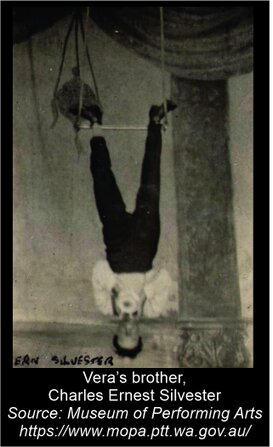

The programme was excellently carried out, and fully merited the applause accorded it. The company will show in the Town Hall to-night and tomorrow night.”
Silvester’s ‘shadow display’ was the long-lived ‘Masks and Faces’ routine, featured by Alf under the title ‘Faces I Have Met.’ It is remarkable that this apparently simple amusement, picked up by the original Fakir in 1867 from Herr Schulze, should have been so popular as to feature prominently in the Silvester family shows for over fifty years.
The cornet performance mentioned was the work of Vera’s brother, Charles Ernest Silvester, who appeared with the show on occasion and acted as the musical director and manager, though he eventually decided that touring was not for him. His big finish to his solo act was to play his trumpet while suspended upside down, hanging by his ankles from a trapeze.
Alf Silvester was not the only magician in town. Les Levante had made his way across the country to arrive in Perth in 1923, and he toured widely before finally departing in 1926. Levante would eventually become Australia’s most famous magical export, but he was only in his early thirties, well younger than Alf, and was still a smaller act, paying his dues by becoming the manager of a small company of performers including the “Aussie Digger” Cass Mahomet. Levante’s wife, Gladys, and daughter, Esme, were with him; the similarities to the Silvester family must have made for many interesting exchanges of information between the two magicians in regard to the tricks and traps of touring and transportation in Western Australia. Levante wrote to “Everyone’s” magazine, “To anybody anticipating a tour of the country towns of this State I would advise that no more than five people be included. The population will not carry a big show, and motor transport is absolutely essential.”
 Other performers on the West Coast were Perth native Claude Guest (‘Wong Toy Sun’) with whom Silvester shared the bill in December 1923 at Fremantle. Carter the Great was at Perth in October 1924, and Illusionist Nicola made a hit in 1929. However, the least desirable of Alf’s encounters was when he was billed at Perth’s White City during the December 1924 carnival season, alongside a show called “Maskelyne’s Mysteries”. The lead performer of this show, which fortunately was quite separate from Alf’s, was one Edward George Durant, an out-and-out shyster with over twenty aliases including ‘Zingara’ and ‘Larenzy’. Durant had previously been convicted of cheque fraud in 1909 and accused of other crimes including a rail heist. Although Durant’s show (misappropriating the famous name ‘Maskelyne’) seems to have been a competent performance, Durant was up to his old tricks, and he was soon hauled up before the courts on charges of presenting dishonoured cheques to the value of several hundred pounds; in March 1925 he was sentenced to nine months’ imprisonment.
Other performers on the West Coast were Perth native Claude Guest (‘Wong Toy Sun’) with whom Silvester shared the bill in December 1923 at Fremantle. Carter the Great was at Perth in October 1924, and Illusionist Nicola made a hit in 1929. However, the least desirable of Alf’s encounters was when he was billed at Perth’s White City during the December 1924 carnival season, alongside a show called “Maskelyne’s Mysteries”. The lead performer of this show, which fortunately was quite separate from Alf’s, was one Edward George Durant, an out-and-out shyster with over twenty aliases including ‘Zingara’ and ‘Larenzy’. Durant had previously been convicted of cheque fraud in 1909 and accused of other crimes including a rail heist. Although Durant’s show (misappropriating the famous name ‘Maskelyne’) seems to have been a competent performance, Durant was up to his old tricks, and he was soon hauled up before the courts on charges of presenting dishonoured cheques to the value of several hundred pounds; in March 1925 he was sentenced to nine months’ imprisonment. Alf added a new illusion to his show – the “Palanquin Mystery” in which an empty wooden shell, (of the type formerly carried on poles to transport wealthy owners), was displayed and then magically produced one or two assistants from within.
The big journey of 1925 was a three-month journey up north to Broome. Even going on a direct route via Geraldton and Meekatharra, it was a trip of 2,000 kilometres in each direction, running with two old cars and a Reo truck. The roads, or more correctly tracks, would sometimes be obscured by spinifex to a degree where the track was invisible. There were few enough towns along the way, and Ida recalls, “most of a country district’s population lived outside the town with perhaps only a few shop-keepers making up the town proper. Some places we visited had only one general store-cum-post office to serve the district. This meant that people had to travel in to town to see the show. It was always a wonderful sight to see the vehicle lights heading into town, they signified that we were going to have an audience, hopefully enough to keep us going. In those days we lived from town to town, from day to day, almost from hand-to-mouth.”
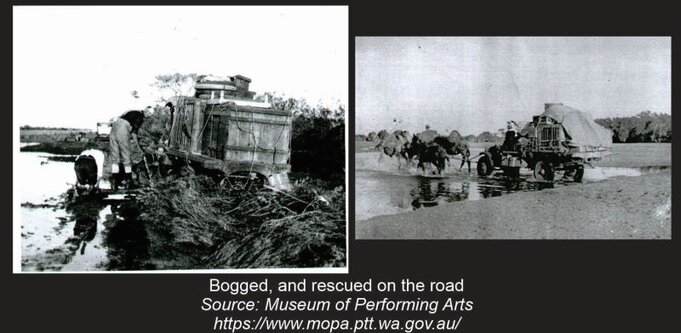
All of the animals were along on the trip, and as performers Alf had the Williams Sisters, and Ernest Silvester and his wife Mary (a professional contralto, billed as Marie Grist). They had now become “Chas. Allan’s Surprise Party” and upon arrival at Broome the company settled at the Continental Hotel, playing three shows weekly with such success that Alf had to invent new routines to provide a change of show. They managed to weather a cyclone which battered the town in January 1926, and finally in late February they headed reluctantly back towards Perth. Along the way, one of Alf’s cars broke an axle and had to be abandoned. Piling the family into the other vehicles, Alf reached Port Hedland where he reported that the car had caught fire due to spinifex on the hot exhaust. The car had indeed been burned, but more for insurance reasons than by accident! The company was then bundled on board ship heading down the coast at least as far as Carnarvon, and returned home to Perth by April 1926.
After the exhausting adventure to Broome, Ernest and Mary decided never to go a-roaming ever again, the Williams Sisters announced that they were departing, and Vera, whose health was never robust, required a bout of recuperation. She was badly afflicted with asthma and in coming years there were visible gaps in advertising where “Princess Vera” was absent from the show.
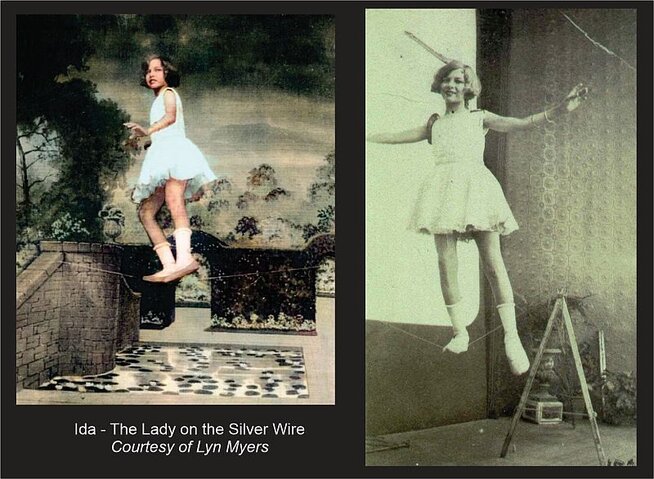 At this time Ida, now ten years old (yet still billed as ‘Baby Ida’!), was taught her first skills in slack-wire walking by Alf. There was no trick or secret to this, just constant practice, intense concentration and good leg balance. Eventually Ida would extend her wire-walking to include a blindfold walk, passing a hoop over her whole body, carrying diamond pythons wrapped around her shoulders (which didn’t faze her in the least), and a surprisingly difficult feat in which she knelt down, while on the wire, to untie a handkerchief around her ankle, all the time battling the constantly shifting centre of gravity. She had another feat of climbing a ladder which was balanced on the wire and, not surprisingly, once broke her elbow in a fall which took her out of action for some weeks. Her skill, with ongoing practice, remained until she was in her fifties and gave away the wire walking after a hip injury. So difficult was the wire-walk that Alf would offer up a friendly challenge to youngsters in the towns to come and try to balance on the wire, something they always failed to do.
At this time Ida, now ten years old (yet still billed as ‘Baby Ida’!), was taught her first skills in slack-wire walking by Alf. There was no trick or secret to this, just constant practice, intense concentration and good leg balance. Eventually Ida would extend her wire-walking to include a blindfold walk, passing a hoop over her whole body, carrying diamond pythons wrapped around her shoulders (which didn’t faze her in the least), and a surprisingly difficult feat in which she knelt down, while on the wire, to untie a handkerchief around her ankle, all the time battling the constantly shifting centre of gravity. She had another feat of climbing a ladder which was balanced on the wire and, not surprisingly, once broke her elbow in a fall which took her out of action for some weeks. Her skill, with ongoing practice, remained until she was in her fifties and gave away the wire walking after a hip injury. So difficult was the wire-walk that Alf would offer up a friendly challenge to youngsters in the towns to come and try to balance on the wire, something they always failed to do.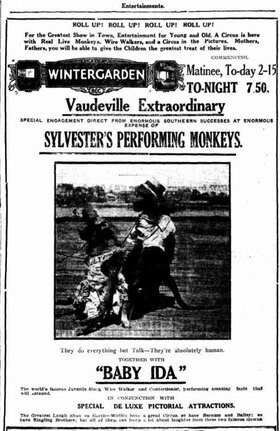
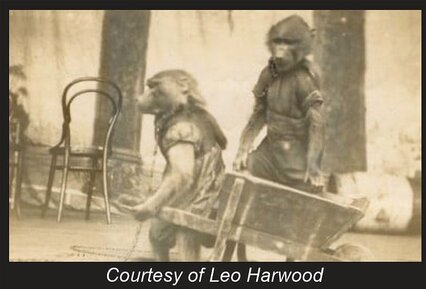
Notably, as time went on the impact of motion pictures was being felt, and often the advertised show was a shared bill with a movie, the advertising solely focused on Silvester’s Performing Monkeys and the slack-wire talents of Baby Ida (“Direct from the Orient”). Vera was still performing but perhaps less often, and the troupe was now ‘Allan’s Bellringers and Entertainers’, featuring Professor Allan (Alf), and a leopard named Prince; we must assume that this was a replacement for Cara.
A gap appears in the newspaper records between March and May 1929. From the Queensland records of births, deaths and marriages we find that on April 30, Alf and Vera were married.
The touring life may have been tiring and challenging, but Queensland had offered several years of sustainable audiences. Times, however, were about to become very tough indeed.
Indicative Tour schedule 1923 - 1936
These are dates found in newspaper articles or advertising. It is highly likely that the Silvesters made many more appearances between the larger townships, in tiny locations where newspaper advertising was unavailable.
1923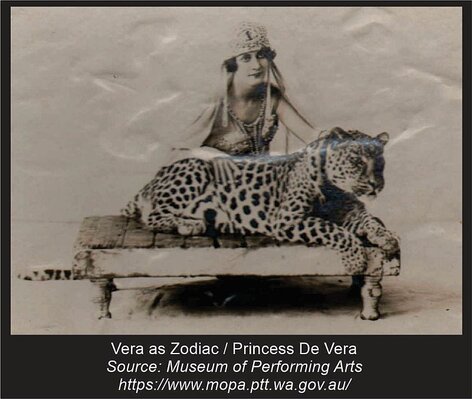
Jan/Feb - Victoria - Horsham, Ouyen
March - Mildura, Red Cliffs
May - Bairnsdale, GippslandJuly - Kaniva, Portland
August – South Australia - Naracoorte, Mt Gambier, Bordertown, Mt Barker
September - NSW - Broken Hill
October - S.A. - Port Pirie
November - Moonta, Yorketown
December – Western Australia - Fremantle
1924
January - W.A. - Bunbury, Perth (Shaftesbury Theatre) to February (met up with Les Levante)
February - Moora, Mullewa, Yalgoo, Meekatharra, Geraldton, Cue
March - Mt. Magnet
April - Merredin, Boulder, Kalgoorlie
July - Claremont, Perth
August - Perth
September - Bunbury, Collie, Katanning
October - Albany, Narrogin, Pingelly
November - Busselton
December - Perth's "White City" all month, alongside 'Maskeyne's Mysteries'- (Edward Durant a.k.a Larenzy)
1925
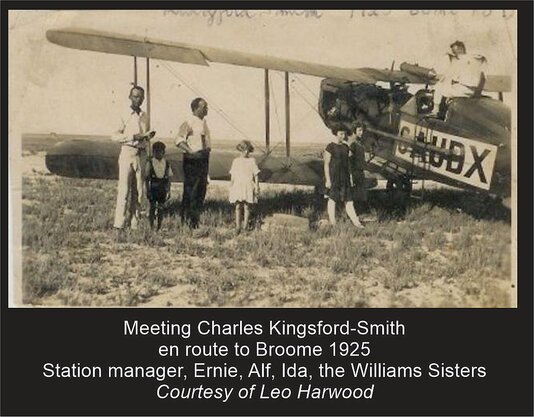
January - W.A. - Cue, Mt. Magnet, Geraldton, Meekatharra
February - Kalgoorlie
March - Northam
June - Meekatharra, Geraldton, Mt. Magnet
July - Boulder
August - Gnowangerup (347km s/east of Perth)
September - Albany
November - Geraldton, Meekatharra (en route to Broome)
1926
January – W.A - Broome
February - Still at Broome to at least Feb20
April - Carnarvon from Hedland as ‘Chas Allan's Surprise Party’
May - Silvester and Zodiac back in Perth after successful North-West season. At Perth Zoo as "The World's Entertainers"
June - Collie
July - touring south west with Silvesters Vaudeville Co. - Albany, Merredin
September - Pingelly, Goomalling, Toodyay
October - York, Narrogin, Wagin
November - Perth, Pinjarra, Holyoake, Bunbury
December - Bridgeton
1927

January – W.A. - Fremantle
February - Northam, Kalgoorlie
April - S.A. - Streaky Bay, Franklin Harbour, Port Lincoln, Cowell
May - Port Augusta
June - Port Pirie
July - Renmark
August - S.A. and VIC - Adelaide (17th-26th), Mildura, Oyen
September – S.A. - Adelaide, NSW - Broken Hill, Wilcannia, (Sept was when Evangeline filed for divorce)
October - NSW – Bourke, Brewarrina, Walgett, Narrabri, Muswellbrook
December - Newcastle, Maitland, Cessnock
1928
January - NSW - Lithgow
February - Camden
March - Berrima
April - Candelo, Bombala
May - Braidwood, Bowral, Robertson, Moss Vale, Crookwell
June - Orange, Katoomba, Forbes
July - Dubbo, Wellington, Bourke
October - QLD - Warwick, Brisbane Tivoli with movie most of month
November - Ipswich
1929
January - QLD - Townsville, Rockhampton, Maryborough, Caboolture
February - Nambour, Toowoomba
March - Dalby, Toowoomba
June - Longreach
July - Charters Towers, Townsville
August - Cairns twice, Innisfail
September - Mackay
October - Rockhampton
November – Maryborough
1930
Great Depression had started in August 1929 in US
March - QLD - Toowoomba, Warwick
April - Toowoomba
May - Roma
July - Cairns
September - Mackay
1931
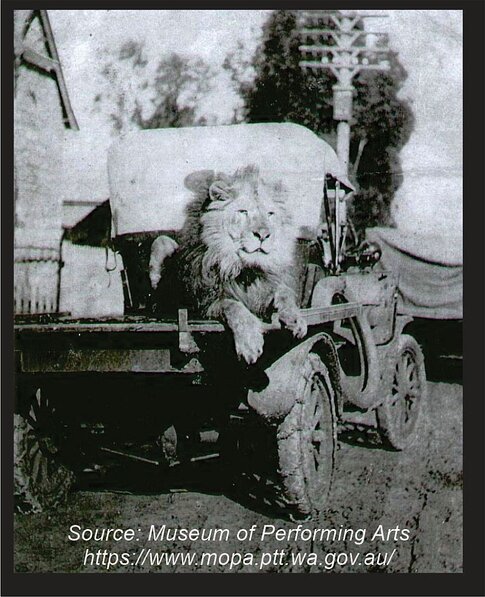
March - QLD - Bundaberg - crowds turned away from the "Canvas Theatre"
May - Dalby as Allan's Entertainers, Roma as the Sill Family
June - Charleville as Sill Family
July - missed booked show in Windorah at far Sth-West near SA border
September - Charters Towers
1932
February – QLD - Rockhampton
April - Townsville
July - Cairns
September - Molloy
October - Cairns with business manager Mr Cosgrove
1933
January – QLD - Rockhampton
March - Blackwater, Emu Park
April - Dingo, Jericho
May - Blair Athol
June - Longreach, Barcaldine
July - Longreach
November - Warialda in Northern NSW
December - Inverell
1934
Sill family or Sils family.
January - Inverell
July – Hillston, Merriwagga
September - Gundagai, Tumut
October - Deniliquin, Hay, Boree Creek
1935
January – NSW – long stay around Inverell (Shirley born there in March)
May - Woodenbong
July - Burringbar
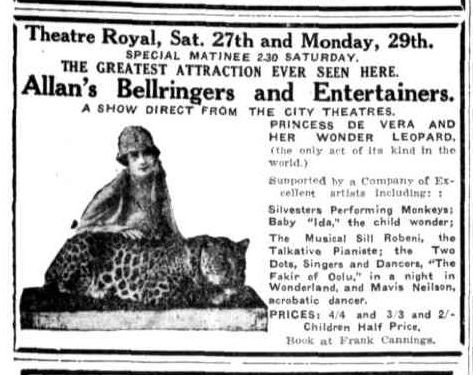
September - QLD - St.George
October - back at Longreach and Charleville, Wyandra, Barcaldine
November - Roma
December – NSW - Broken Hill and extended stay till Jan 9 1936
1936
January – NSW at Broken Hill then Mildura VICMarch – NSW - Hillston
May - S.A. - Yorketown
July - Kadina
August - Port Augusta, Quorn
September - Port Lincoln, Streaky Bay
October - Streaky Bay, Ceduna, Port Lincoln
November - Kimba
December – W.A. - at Luxor Theatre Perth and then into 1937
REFERENCES FOR CHAPTER THIRTEEN
(1) Ida Harwood’s biographical memoir, c.1995 is held in printed form at the State Library of Western Australia. It was written in conjunction with library researcher, David Charlton, and printed & produced by Leo Harwood, Ida’s son, in less than twenty copies. As well, the library holds two sound recordings of interviews with Ida Harwood – one from the late 1980s, interviewer John Robinson for the Musicians’ Union of Australia oral history project, and a 1991 interview with David Charlton.
(2) Ida’s memoir makes reference to her grandmother having come from Moree. Records show, however, that Eleanor Whaley was born in Heathcote Victoria, where her mother ran a millinery and dressmaking shop in High Street, while her father operated a day and night school. They appear to have relocated to Melbourne by 1870.
(3) The Silvester store may have had two locations, the first being at Broome Street where Eleanor was living in 1902, but the principal location was at 313 Hay Street, Subiaco, where the original building still stands.
(4) Ida states that it was the Woodman Point quarantine station, but the Daily News August 13 1919 refers to Blackboy Hospital.
(5) In a memorial notice a year later, Elinor’s daughters wrote “Her life was all unselfishness, Her end was perfect peace.”
(6) Queensland Births/Deaths/Marriage search at www.familyhistory.bdm.qld.gov.au